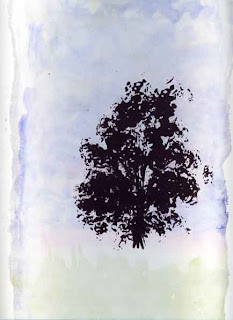Printmaking 08: Tree screen/monoprint (final)

To complete the final stage in the tree image, I painted a pale watercolour wash directly onto a blank screen, let it dry, then squeegeed acrylic medium through the screen onto the tree. The colours are olive green at the bottom with an alizarin and cobalt mix in the middle graduating to pure cobalt at the top. The result is attractive and reasonably close to the effect I wanted to achieve. There is a good mix of soft, blended colour with a crisp edge where the medium has dried onto the paper, giving a slightly raised texture. (Sadly, the colours haven't come out as well in the scanned image as well as they look in real life. Also, the proportions are different -- my scanner isn't big enough to accommodate the whole image. I tried scanning it in as separate halves and stitching it together in Photoshop, but it doesn't look right)
Trial and error has taught me that many thin layers of wash work better than one thick one to produce the soft pastel effect that I was after. There are a few too many obvious brush marks left whereas my ambition was to create a gradient wash but it's quite difficult to see what's happening on the screen. I'm not unhappy, but it's difficult to know how to resolve this for next time. I'm told that part of the problem could be that the watercolours I'm using (cheap student-grade WH Smith specials) aren't quite cheap enough. It takes ages for the colour to 'register' as you push the acrylic medium through the screen and I had to go over and over the same prints several times to achieve the results I got. Apparently little kids' watercolours work the best for this ... the very cheap pigments 'float' on the top and allow you to achieve richer colours with less work.
Paradoxically, working with a thicker application of watercolour, e.g., straight from the tube, doesn't necessarily give you more colour quicker. It takes just as long -- lots of repetitious squeegee work on the screen -- and the results are interesting, but less controllable. An example can be seen on the later variants of the life energy prints.
